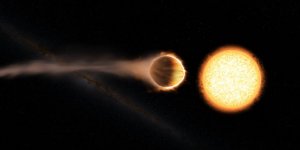| News / Space News |
New Gravity Map Suggests Mars Has a Porous Crust
NASA scientists have found evidence that Mars’ crust is not as dense as previously thought, a clue that could help researchers better understand the Red Planet’s interior structure and evolution.

A new map of the thickness of Mars’ crust shows less variation between thicker regions (red) and thinner regions (blue), compared to earlier mapping. This view is centered on Valles Marineris, with the Tharsis Montes near the terminator to its west. ![]()
A lower density likely means that at least part of Mars’ crust is relatively porous. At this point, however, the team cannot rule out the possibility of a different mineral composition or perhaps a thinner crust.
The crust is the end-result of everything that happened during a planet’s history, so a lower density could have important implications about Mars’ formation and evolution.
The researchers mapped the density of the Martian crust, estimating the average density is 2,582 kilograms per meter cubed (about 161 pounds per cubic foot). That’s comparable to the average density of the lunar crust.
Typically, Mars’ crust has been considered at least as dense as Earth’s oceanic crust, which is about 2,900 kilograms per meter cubed (about 181 pounds per cubic foot).
The new value is derived from Mars’ gravity field, a global model that can be extracted from satellite tracking data using sophisticated mathematical tools. The gravity field for Earth is extremely detailed, because the data sets have very high resolution.
The data sets for Mars don’t have as much resolution, so it’s more difficult to pin down the density of the crust from current gravity maps. As a result, previous estimates relied more heavily on studies of the composition of Mars’ soil and rocks.
From the new model, the team generated global maps of the crust’s density and thickness. These maps show the kinds of variations the researchers expect, such as denser crust beneath Mars’ giant volcanoes. (NASA)
YOU MAY ALSO LIKE



